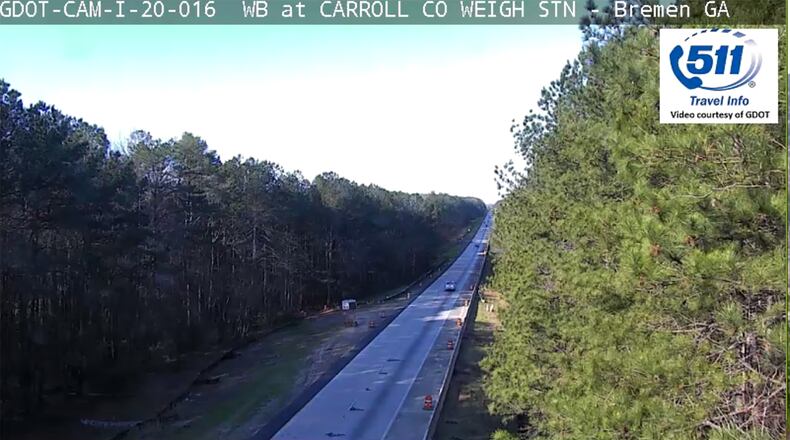The crossover from February into March was a strange and annoying one for I-20 motorists in Villa Rica. Multiple tractor trailer crashes broke out in a four-day stretch, seemingly out of nowhere. The wrecks blocked lanes on either side of I-20 between Highway 61/Villa Rica (exit 24) and Highway 27 (exit 11). Most of the wrecks were on the eastbound side, just after Highway 113/Temple (exit 19). Why did trucks just start wrecking with such frequency here?
GDOT has been working long term in each direction in the area. Any construction zone is automatically more dangerous, as shoulders can be closed, lanes re-striped, or even lanes closed. Any ripple in the traffic continuum ups the chances of wrecks and delays. But this Carroll County work zone has been ongoing for a long time — why did these crashes suddenly break loose?
WSB Traffic Troopers called our 24-Hour Traffic Center to say that mud from the persistent construction zone washed onto the freeway and caused vehicles to lose control. When we received word of this, Ashley Frasca from our Traffic Team alerted GDOT officials, who responded promptly that they would investigate the problem. But the crashes continued for the next few days. I reached out to GDOT again this past week to see where things stood.
First, the project itself is to rehabilitate the concrete of the freeway. Crews are also upgrading the guardrails and guidewires and reconstructing the shoulders, GDOT said.
“The shoulder reconstruction includes widening these shoulders, not the roadway, by two feet, which requires some vegetation clearance,” GDOT spokesperson Natalie Dale said via email. “This component of the project may be the reason for the much-complained-about mud and debris in the work zone.”
The 12-mile stretch of projects began in October 2016 and any lane closures largely have taken place at night. However, a new fold in the project began right in the middle of when these wrecks took place.
“In addition, the contractor is currently working on shoulder reconstruction along three miles of I-20 eastbound between milepost 12 and milepost 15,” Dale explained. “The work began Friday, March 2nd. It required a single lane closure. This lane closure limited the eastbound traffic to one lane.”
That closure caused a big jam on I-20/eastbound before Highway 27 (exit 11). During PM drive that Friday, a big rig crash actually shut down I-20/eastbound a few miles east of the closure. This meant those coming toward Downtown Atlanta from Alabama got hit with big jams twice.
But why did these crashes suddenly break out at this time? Did something with the road work change? The new lane closure on I-20/eastbound began two days after our WSB Traffic Team started noticing these concurrent wrecks. Dale offered a differing view.
“In speaking with the district, there does not seem to be any more crashes than usual — likely just seemed worse due to the combination of crashes and the lane closure.”
This stretch of I-20 has far fewer crashes than the more populous parts of metro Atlanta. For this many to have happened so close together, something had to be different.
Atlanta got quite a bit of rain the Sunday before the wrecks (February 25th) and a strong storm system moved through on the Thursday during the crash-filled few days. The precipitation had to have made the mud worse. Two commuters I spoke to from that area said that the mud was indeed an issue and they tried to avoid that stretch all together, using Highway 78.
There lies the possibility that there technically was not an abnormal amount of wrecks on I-20 between Villa Rica and Temple between Wednesday, February 28th and Saturday, March 3rd. But the wrecks that did take place were much worse, involving big trucks, multiple lane blockages, and major delays. If the mud or the construction — or both — were the cause, then GDOT needs to work to make the area safer.
We have heard from commuters before about the nearly non-existent lane striping in the I-75 Cobb County work zone and issues with standing water on I-85 in north Gwinnett. Drivers struggle enough in perfect conditions, so standing flaws in construction zones need addressing. And drivers need to take note also and slow down when conditions are imperfect.
About the Author
The Latest
Featured


